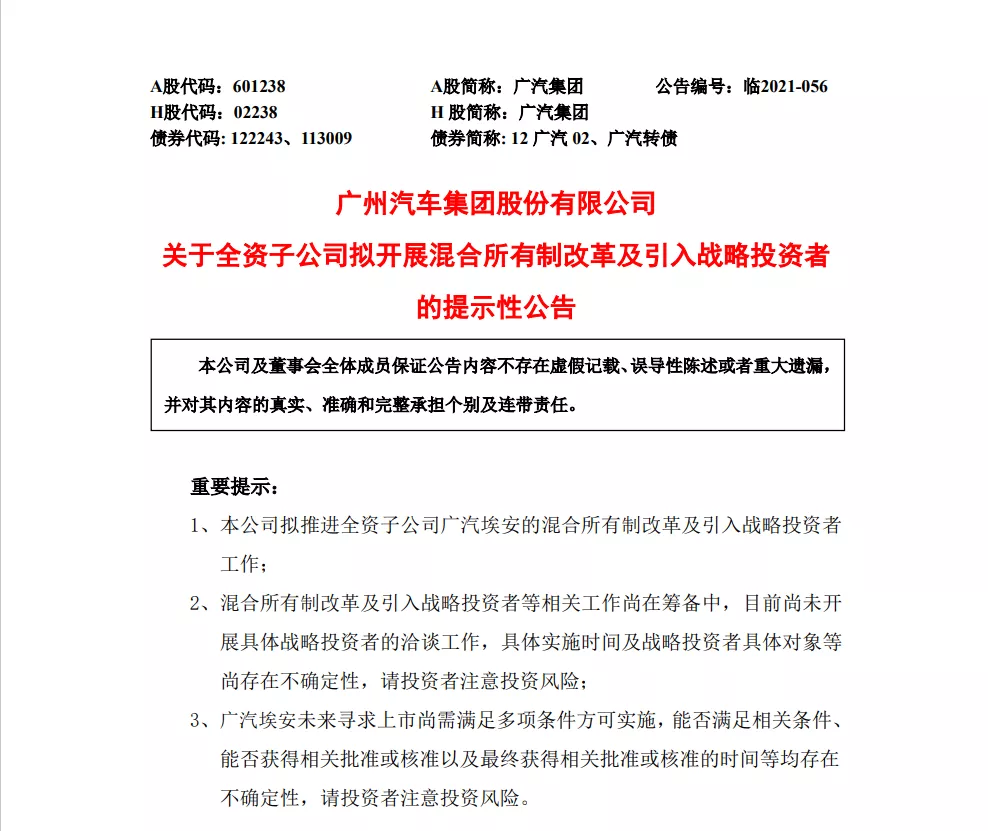GoingHundred, a media company under Outing Group, focuses on the evolution of the automobile and travel industry chain
Author: Pei Zhou
Some people say that capital is a good thing, while others say that capital is not good.
Whether it is good or not depends on who the beneficiary is and who the victim is.
For example, in recent years, the stock incentive plans launched by companies such as Changan, Great Wall, and Geely, as well as the mixed-ownership reform launched by GAC Aion and the subsequent IPO, have all been beneficial to the employees.
However, there is no such thing as a free lunch. To enjoy delicious food, one must pay an appropriate price.
The success of BMW China’s acquisition of the “Zhonghua” car brand means that HuaChen Group is, to some extent, the victim, and its overall bankruptcy reorganization plan will be in vain.
A blessing in disguise. At least for Liaoning and Shenyang, the assets of HuaChen Automobile Manufacturing Co. Ltd. can be revitalized.
“This is giving away money for free,” the bystanders exclaimed, “what a good boss in China.”
What’s going on? The popular “stock incentive plan” was launched by many auto companies, and as the leader of independent brands, how could Geely lag behind?
On August 30th, Geely announced that the board of directors had approved a stock incentive plan with a total of no more than 350 million shares, and the first batch of plans would award approximately 167 million shares to 10,884 motivated parties.
In summary, Geely has spent 350 million shares to incentivize employees with a face value of 0.02 yuan per share, which is very low cost. The purpose of the stock incentive plan is to encourage motivated parties to continue to contribute while attracting and retaining high-quality employees.
However, in addition to binding talent, Geely has deeper reasons for launching the stock incentive plan. In the past two years, as Changan moves to the fast lane after the adjustment period, Great Wall has released multiple technological platforms and multi-brand alliances, and Geely feels a bit restive.
Compared with the stock incentive plans of Changan Auto, Great Wall Auto, SAIC, and GAC, Geely Auto’s employee stock incentive plan has the largest scale and the lowest cost of employee investment.
It seems to be giving it away for free, but it’s not easy to get. Any stock incentive plan needs a target, and no automaker is an exception.
Previously, Changan’s stock incentive plan required holders to achieve the goal of continuous revenue growth for the company over the next three years to exercise their rights. This year, Great Wall’s equity incentive plan has a more concrete goal: the performance targets for the period between 2021 and 2023 are 1.49 million vehicles, 1.9 million vehicles, and 2.8 million vehicles, with net profit targets of RMB 6.8 billion, RMB 8.2 billion, and RMB 11.5 billion, respectively.
Meeting Geely’s strict performance targets is no easy feat. Core strategic indicators include sales volume, with a clear target of no less than 3 million cars sold annually by 2025. In addition, Geely must also maintain its position as the top Chinese brand in market share during this period.
Achieving the 3 million sales target is still highly possible, especially with the sales growth potential from new market players such as Xpeng. However, the market share target is ambiguous, as it is not explicitly stated whether it is Geely’s total sales compared with the overall market, or its sales in specific market segments. Presumably, the former is more likely, but it will be much harder to attain than the 3 million sales target.
Furthermore, uncertainties abound in the automotive industry, and market direction does not always follow the heart’s compass.
In 2016, when Changan Automobile introduced its stock option incentive plan, the company had been in a three-to-four-year adjustment period, and its performance did not meet expectations, resulting in the failure of the incentive plan.
Today’s automotive market has undergone tremendous changes compared to Changan’s adjustment period. Various cross-sector companies have entered the market and are competing relentlessly. The competition has gone beyond whose pockets are deeper and also involves who can seize the direction of the wind.
Seizing the direction of the wind is like a heavy burden on traditional automakers. It is like an elephant dancing with shackles on its feet, and the weight is overwhelming. Therefore, even free stock options are not easy to obtain.
#
A single announcement confirms a rumor among the public.
On August 30th, GAC Aion made an official statement about mixed ownership reform. Within less than a year, from being an independent brand to promoting mixed ownership, GAC Aion officially settled on its “flying solo” plan.
According to an announcement by GAC Group, the mixed ownership reform of GAC Aion will be promoted by integrating and reorganizing the new energy vehicle research and development capabilities and businesses, and seeking appropriate opportunities for listing.
Mixed ownership reform is not a new phenomenon, but the “three-piece suit” of mixed ownership reform requires GAC Aion to answer the questions of “what to change,” “why change it,” and “what is the goal of the reform?”
The simplest and most direct question from the market is whether GAC Aion’s mixed ownership reform is aimed at funding. Experts in the industry believe that after nine months of being an independent brand, putting the listing on the agenda is a sign of financial difficulties.
In response to this question from the public, Gu Huinan, the general manager of GAC Aion New Energy Vehicle Co., Ltd., publicly stated that GAC Aion’s mixed ownership reform is not financially motivated. Instead, it hopes to use capital to enhance the brand, to retain talent through employee shareholding, and to stimulate creativity.
 ##
##
However, from the perspective of capital, financing is inevitably one of the important goals. Although GAC Aion continuously released good news in product sales, production capacity, and technology, it did not bring GAC Group the benefits of new energy vehicles. Recently, although GAC’s stock price hit a new high, it still failed to break through 20 yuan/share, and its market value is still low.
Overall, GAC’s revenue is growing, but it has not yet made a profit in the new energy sector. GAC Group needs GAC Aion to take up the banner of new energy vehicle sales and achieve the goal of independent brands accounting for 50% of new energy vehicles. To achieve this, GAC Aion must release more energy in the capital market.
Gu Huinan said, “Nowadays, ordinary people feel that these brands driven by capital represent the direction of the future and have more strength because everyone knows that capital will invest a lot of effort to constantly promote them. This background motivates us to consider the influence of the capital market.”
This is what Gu Huinan said, GAC Aion is not short of money, but it also needs to enter the competition in the capital market. Some investors have stated that GAC Aion is expected to raise no less than 10 billion yuan in Series A financing this year.
The second purpose of mixed ownership reform is mainly to consider innovation in institutional mechanisms. After the mixed ownership reform of GAC Aion, Gu Huinan said that the direction of the reform is to have employees hold stocks while also introducing strategic investors.
So after the mixed ownership reform, can GAC Aion further “breakthrough”? Everything is just beginning, and the answer is unknown.
However, on the day when the mixed ownership reform was announced, GAC Aion released the “Charging for 5 Minutes, Traveling 200km” ultra-fast battery technology and A480 supercharging pile to demonstrate its strength.
After BMW increased its stake in Brilliance BMW to 75%, it made people sigh in just three years.
On August 31, the second creditor’s meeting for the substantial merger and restructuring of 12 companies including Huachen Automotive Group was held. The core resolution of the meeting was that BMW China acquired the “Zhonghua” automobile brand.
The resolution was approved by the creditors through voting. Among the core resolutions, BMW China purchased the relevant assets of the “Zhonghua” automobile brand for 1.633 billion yuan. Among them, the proposal for BMW to acquire the assets of the “Zhonghua” automobile brand was the resolution with the lowest approval rate among the three resolutions. The agreed amount only accounted for 57% of the total amount of creditor’s rights present at the meeting, just exceeding the minimum limit of 50%.
BMW’s acquisition of the “Zhonghua” assets was passed with a low number of votes. This is because for Huachen Group, the success of the acquisition resolution means that the overall bankruptcy restructuring will be in vain. Other remaining assets of Huachen Group will also be split and sold, but there are great difficulties in whether they can be sold or not. Once Huachen China’s equity cannot be sold, most creditors will not be able to make claims.Currently, under the Huachen Group, there are three brands: “Zhonghua,” “Jinbei,” and “Huasong,” as well as two joint venture brands, “Brilliance BMW” and “Brilliance Renault,” covering the entire field of passenger and commercial vehicles. Among Huachen’s assets, the largest is Huachen China’s equity of 10.3 billion yuan, followed by Jinbei’s equity of 1.93 billion yuan, and Zhonghua’s brand assets of 1.233 billion yuan.
From the announcement, BMW is acquiring two types of assets: the production assets of the “Zhonghua” brand of automobiles and 100% equity of Brilliance Auto. As Huachen’s largest asset, BMW is not interested in Huachen China’s equity at all.
So, what did BMW see in Huachen Zhonghua for the 1.6 billion yuan? And what is BMW’s real intention in this investment?
Obviously, BMW is not interested in the mediocre products and brand premiums of the Zhonghua brand. What is left that can attract BMW is the production qualifications of the entire vehicle.
Although many new forces have previously acquired weak traditional auto companies in this way, it was only for obtaining production qualifications. However, BMW does not need Huachen Zhonghua to increase production qualifications.
So, what is left for Huachen Zhonghua to attract BMW is production factories and equipment. However, a new problem arises: Can the “Zhonghua” brand revive in the hands of BMW? Will BMW revive this extremely weak brand?
The answer is hardly.
Of course, the independent operation of the “Zhonghua” brand in the hands of BMW is a desired outcome. However, it is clear that BMW will not do so. On the one hand, BMW is not a company that enjoys managing many brands. On the other hand, BMW only spent 1.6 billion yuan, which is the price of developing a single car model, to acquire a brand whose basic value is almost zero. Obviously, BMW will not spend a lot of money on this low-value brand.
Moreover, what BMW China has purchased is the tangible assets of the “Zhonghua” brand, which does not include the intangible asset of the brand itself. In the announcement, BMW clearly stated, “We hope to use the existing production capacity of Brilliance Auto.”
Once BMW takes away all the production elements produced by Huachen, then Huachen Zhonghua will be basically destined to cease to exist. For BMW, spending 1.6 billion can obtain a greater support from Liaoning province, which BMW regards as “the cornerstone of its success in China.”
This article is a translation by ChatGPT of a Chinese report from 42HOW. If you have any questions about it, please email bd@42how.com.